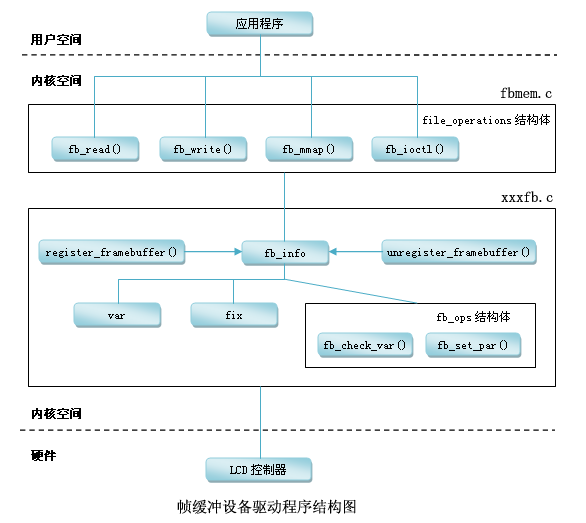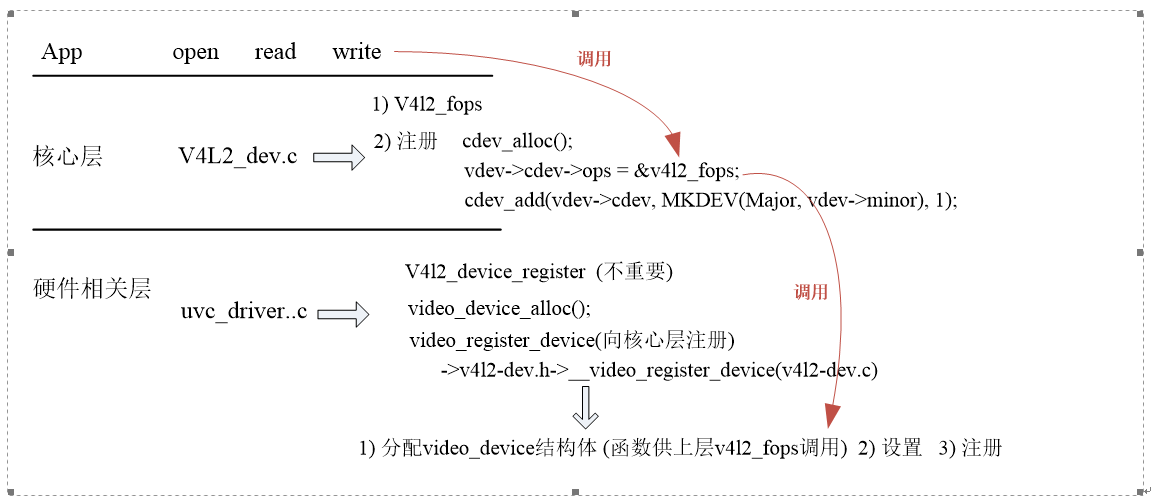学习目标:学习V4L2(V4L2:vidio for linux version 2)摄像头驱动框架,分析vivi.c(虚拟视频硬件相关)驱动源码程序,总结V4L2硬件相关的驱动的步骤;
一、V4L2架构
1. 字符类驱动
V4L2(V4L2:vidio for linux version 2)摄像头驱动属于字符类驱动,
对于一般的字符类驱动程序,其编写步骤一般分为:
1)构造一个file_operations: 编写open=drv_open .read=drv_read
2)注册设备,告诉内核:register_chrdev(主设备号,名字,&file_operations)
3)入口函数:调用register_chrdev
4)出口函数:卸载
对于复杂的字符类驱动程序,其程序是一种分层结构。例如LCD驱动程序。如下图所示。
--> 上层为核心层(内核已经做好的),在fbmem.c中 ,主要的作用为:
1)构造file_operations(open read write 函数);2)注册;3)入口、出口。
--> 硬件相关层(用户需要做的),供核心层的file_operations调用,主要完成:
1) 分配一个fb_info 结构体;2) 设置fb_info 结构体等;3) 注册;4) 硬件相关的操作。

2. V4L2驱动架构
由以上字符类设备驱动架构可知,摄像头驱动也是分层结构的。

其中,ucv_driver.c中,定义了uvc_driver结构体,根据ucv_ids查找匹配的设备,如果支持,则会进入probe函数
1 struct uvc_driver uvc_driver = {
2 .driver = {
3 .name = "uvcvideo",
4 .probe = uvc_probe,
5 .disconnect = uvc_disconnect,
6 .suspend = uvc_suspend,
7 .resume = uvc_resume,
8 .reset_resume = uvc_reset_resume,
9 .id_table = uvc_ids,
10 .supports_autosuspend = 1,
11 },
12 };二. vivi.c虚拟视频驱动程序架构
由于V4L2驱动程序是一种分层架构,用户只需要完成硬件相关驱动程序即可。这里主要以vivi虚拟视频驱动程序为例分析源码的调用过程和框架。
1. 进入入口的vivi_init(void)函数:
1 static int __init vivi_create_instance(int inst)
2 {
3 struct vivi_dev *dev;
4 struct video_device *vfd; //video_device结构体定义
5 struct v4l2_ctrl_handler *hdl;
6 struct vb2_queue *q;
7 int ret;
8
9 dev = kzalloc(sizeof(*dev), GFP_KERNEL);
10 if (!dev)
11 return -ENOMEM;
12
13 snprintf(dev->v4l2_dev.name, sizeof(dev->v4l2_dev.name),
14 "%s-%03d", VIVI_MODULE_NAME, inst);
15 ret = v4l2_device_register(NULL, &dev->v4l2_dev);
16 if (ret)
17 goto free_dev;
18 //摄像头相关属性设置
19 dev->fmt = &formats[0];
20 dev->width = 640;
21 dev->height = 480;
22 hdl = &dev->ctrl_handler;
23 v4l2_ctrl_handler_init(hdl, 11);
24 dev->volume = v4l2_ctrl_new_std(hdl, &vivi_ctrl_ops,
25 V4L2_CID_AUDIO_VOLUME, 0, 255, 1, 200);
26 dev->brightness = v4l2_ctrl_new_std(hdl, &vivi_ctrl_ops,
27 V4L2_CID_BRIGHTNESS, 0, 255, 1, 127);
28 dev->contrast = v4l2_ctrl_new_std(hdl, &vivi_ctrl_ops,
29 V4L2_CID_CONTRAST, 0, 255, 1, 16);
30 dev->saturation = v4l2_ctrl_new_std(hdl, &vivi_ctrl_ops,
31 V4L2_CID_SATURATION, 0, 255, 1, 127);
32 dev->hue = v4l2_ctrl_new_std(hdl, &vivi_ctrl_ops,
33 V4L2_CID_HUE, -128, 127, 1, 0);
34 dev->autogain = v4l2_ctrl_new_std(hdl, &vivi_ctrl_ops,
35 V4L2_CID_AUTOGAIN, 0, 1, 1, 1);
36 dev->gain = v4l2_ctrl_new_std(hdl, &vivi_ctrl_ops,
37 V4L2_CID_GAIN, 0, 255, 1, 100);
55 /* initialize queue */
56 q = &dev->vb_vidq;
57 memset(q, 0, sizeof(dev->vb_vidq));
58 q->type = V4L2_BUF_TYPE_VIDEO_CAPTURE;
59 q->io_modes = VB2_MMAP | VB2_USERPTR | VB2_READ;
60 q->drv_priv = dev;
61 q->buf_struct_size = sizeof(struct vivi_buffer);
62 q->ops = &vivi_video_qops;
63 q->mem_ops = &vb2_vmalloc_memops;
64
65 vb2_queue_init(q);
66
67 mutex_init(&dev->mutex);
68
69 /* init video dma queues */
70 INIT_LIST_HEAD(&dev->vidq.active);
71 init_waitqueue_head(&dev->vidq.wq);
72
73 ret = -ENOMEM;
//分配video_device结构体
74 vfd = video_device_alloc();
75 if (!vfd)
76 goto unreg_dev;
77 //设置
78 *vfd = vivi_template;
/******************************************************************
其中,以赋值的方式进行设置vfd,进入vivi_template:
.name = "vivi",
.fops = &vivi_fops,
.ioctl_ops = &vivi_ioctl_ops,
.release = video_device_release,
.current_norm = V4L2_STD_NTSC_M,
};
*******************************************************************//
79 vfd->debug = debug;
80 vfd->v4l2_dev = &dev->v4l2_dev;
81 set_bit(V4L2_FL_USE_FH_PRIO, &vfd->flags);
82
83 /*
84 * Provide a mutex to v4l2 core. It will be used to protect
85 * all fops and v4l2 ioctls.
86 */
87 vfd->lock = &dev->mutex;
88 //注册
89 ret = video_register_device(vfd, VFL_TYPE_GRABBER, video_nr);
93 video_set_drvdata(vfd, dev);
94
95 /* Now that everything is fine, let's add it to device list */
96 list_add_tail(&dev->vivi_devlist, &vivi_devlist);
97
101 dev->vfd = vfd;
102 v4l2_info(&dev->v4l2_dev, "V4L2 device registered as %s\n",
103 video_device_node_name(vfd));
104 return 0;
107 video_device_release(vfd);110 v4l2_device_unregister(&dev->v4l2_dev);114 }vivi_init函数的调用结构如下:
vivi_init
-->vivi_create_instance
-->v4l2_device_register // 不是主要, 只是用于初始化一些东西,比如自旋锁、引用计数
vfd = video_device_alloc(); //分配video_device结构体
1. *vfd = vivi_template; // 设置
.fops = &vivi_fops,
.ioctl_ops = &vivi_ioctl_ops,
.release = video_device_release,
2. vfd->v4l2_dev = &dev->v4l2_dev;
3. 设置"ctrl属性"(用于APP的ioctl):
v4l2_ctrl_handler_init(hdl, 11);
dev->volume = v4l2_ctrl_new_std(hdl, &vivi_ctrl_ops,
V4L2_CID_AUDIO_VOLUME, 0, 255, 1, 200);
dev->brightness = v4l2_ctrl_new_std(hdl, &vivi_ctrl_ops,
V4L2_CID_BRIGHTNESS, 0, 255, 1, 127);
dev->contrast = v4l2_ctrl_new_std(hdl, &vivi_ctrl_ops,
V4L2_CID_CONTRAST, 0, 255, 1, 16);
4. video_register_device(vfd, VFL_TYPE_GRABBER, video_nr); //注册
--> __video_register_device(vdev, type, nr, 1, vdev->fops->owner);
-->vdev->cdev = cdev_alloc(); (v4l2.dev.c程序中)
vdev->cdev->ops = &v4l2_fops;
cdev_add(vdev->cdev, MKDEV(VIDEO_MAJOR, vdev->minor), 1);
2. vivi.c的open,read,write,ioctl过程
1 static const struct v4l2_file_operations vivi_fops = {
2 .owner = THIS_MODULE,
3 .open = v4l2_fh_open,
4 .release = vivi_close,
5 .read = vivi_read,
6 .poll = vivi_poll,
7 .unlocked_ioctl = video_ioctl2, /* V4L2 ioctl handler */
8 .mmap = vivi_mmap,
9 };1)open
app: open("/dev/video0",....)向下层调用
-------------------------------------------------------------------
drv: v4l2_fops.v4l2_open
vdev = video_devdata(filp); // 根据次设备号从数组中得到video_device
return video_device[iminor(file->f_path.dentry->d_inode)];
if (vdev->fops->open) //如果有open函数
if (video_is_registered(vdev))
ret = vdev->fops->open(filp);//调用open 函数
调用vivi.c 里的v4l2_fh_open函数
2)read
app: read("/dev/video0",....)向下层调用
-------------------------------------------------------------------
drv: v4l2_fops.v4l2_read
struct video_device *vdev = video_devdata(filp);
if (video_is_registered(vdev))
ret = vdev->fops->read(filp, buf, sz, off);
调用vivi.c 里的vivi_read
app: ioctl
----------------------------------------------------
drv: v4l2_fops.unlocked_ioctl => v4l2_ioctl
struct video_device *vdev = video_devdata(filp);
if (video_is_registered(vdev))
ret = vdev->fops->unlocked_ioctl(filp, cmd, arg);
调用vivi.c 里的video_ioctl2
video_usercopy(file, cmd, arg, __video_do_ioctl); //从用户空间把用户的命令cmd复制进来,调用__video_do_ioctl
__video_do_ioctl
struct video_device *vfd = video_devdata(file); // 根据次设备号从数组中得到video_device
switch (cmd) { ..... // 根据APP传入的cmd来获得、设置"某些属性"
{
struct v4l2_queryctrl *p = arg;
if (vfh && vfh->ctrl_handler)
ret = v4l2_queryctrl(vfh->ctrl_handler, p);
else if (vfd->ctrl_handler) // 在video_register_device设置 vivi_create_instance-->hdl = &dev->ctrl_handler; v4l2_ctrl_handler_init(hdl, 11);
ret = v4l2_queryctrl(vfd->ctrl_handler, p); // 根据ID在ctrl_handler里找到v4l2_ctrl,返回它的值
1 hdl = &dev->ctrl_handler;
2 v4l2_ctrl_handler_init(hdl, 11);
3 dev->volume = v4l2_ctrl_new_std(hdl, &vivi_ctrl_ops,
4 V4L2_CID_AUDIO_VOLUME, 0, 255, 1, 200);
5 dev->brightness = v4l2_ctrl_new_std(hdl, &vivi_ctrl_ops,
6 V4L2_CID_BRIGHTNESS, 0, 255, 1, 127);
7 dev->contrast = v4l2_ctrl_new_std(hdl, &vivi_ctrl_ops,
8 V4L2_CID_CONTRAST, 0, 255, 1, 16);
9 dev->saturation = v4l2_ctrl_new_std(hdl, &vivi_ctrl_ops,
10 V4L2_CID_SATURATION, 0, 255, 1, 127);
11 dev->hue = v4l2_ctrl_new_std(hdl, &vivi_ctrl_ops,
12 V4L2_CID_HUE, -128, 127, 1, 0);
13 dev->autogain = v4l2_ctrl_new_std(hdl, &vivi_ctrl_ops,
14 V4L2_CID_AUTOGAIN, 0, 1, 1, 1);
15 dev->gain = v4l2_ctrl_new_std(hdl, &vivi_ctrl_ops,
16 V4L2_CID_GAIN, 0, 255, 1, 100);三、怎么写v4l2驱动?
1. 分配、设置、注册:v4l2_device --》 v4l2_device_register()(辅助作用,提供自旋锁、引用计数等功能)
2. 分配一个video_device:video_device_alloc()
3. 设置
1)vfd->v4l2_dev
2) .fops 设置vfd的fops 里的open、read、write 被上层调用
.ioctl_ops 设置属性被上层调用
3)注册:video_register_device()
4. 接下来,应用层App可以通过ioctl来设置(获得)亮度等某些属性,在驱动程序里,谁来接收、存储、设置到硬件(提供这些信息)?
在驱动程序中抽象出来一个结构体v4l2_ctrl,每个Ctrl对应其中的一项(音量、亮度等等);
v4l2_ctrl_handler来管理他们,在vivi.c的vivi_create_instance函数中:
1.初始化
v4l2_ctrl_handler_init
2.设置
v4l2_ctrl_new_std
v4l2_ctrl_new_custom
这些函数就是创建各个属性,并且放入v4l2_ctrl_handler的链表
3.跟vdev关联
dev->v4l2_dev.ctrl_handler = hdl;
1 static int __init vivi_create_instance(int inst)
2 {
3 struct vivi_dev *dev;
4 struct video_device *vfd;
5 struct v4l2_ctrl_handler *hdl; //定义v4l2_ctrl_handler结构体
6 struct vb2_queue *q;
7 int ret;
8
9 dev = kzalloc(sizeof(*dev), GFP_KERNEL);
10 if (!dev)
11 return -ENOMEM;
12
13 snprintf(dev->v4l2_dev.name, sizeof(dev->v4l2_dev.name),
14 "%s-%03d", VIVI_MODULE_NAME, inst);
15 ret = v4l2_device_register(NULL, &dev->v4l2_dev);
16 if (ret)
17 goto free_dev;
18
19 dev->fmt = &formats[0];
20 dev->width = 640;
21 dev->height = 480;
22 hdl = &dev->ctrl_handler;
23 v4l2_ctrl_handler_init(hdl, 11); //初始化
24 dev->volume = v4l2_ctrl_new_std(hdl, &vivi_ctrl_ops, //创建一个属性设置其值,并且放入v4l2_ctrl_handler的链表
25 V4L2_CID_AUDIO_VOLUME, 0, 255, 1, 200);
26 dev->brightness = v4l2_ctrl_new_std(hdl, &vivi_ctrl_ops,
27 V4L2_CID_BRIGHTNESS, 0, 255, 1, 127);
28 dev->contrast = v4l2_ctrl_new_std(hdl, &vivi_ctrl_ops,
29 V4L2_CID_CONTRAST, 0, 255, 1, 16);
30 dev->saturation = v4l2_ctrl_new_std(hdl, &vivi_ctrl_ops,
31 V4L2_CID_SATURATION, 0, 255, 1, 127);
32 dev->hue = v4l2_ctrl_new_std(hdl, &vivi_ctrl_ops,
33 V4L2_CID_HUE, -128, 127, 1, 0);
34 dev->autogain = v4l2_ctrl_new_std(hdl, &vivi_ctrl_ops,
35 V4L2_CID_AUTOGAIN, 0, 1, 1, 1);
36 dev->gain = v4l2_ctrl_new_std(hdl, &vivi_ctrl_ops,
37 V4L2_CID_GAIN, 0, 255, 1, 100);
38 dev->button = v4l2_ctrl_new_custom(hdl, &vivi_ctrl_button, NULL);
39 dev->int32 = v4l2_ctrl_new_custom(hdl, &vivi_ctrl_int32, NULL);
40 dev->int64 = v4l2_ctrl_new_custom(hdl, &vivi_ctrl_int64, NULL);
41 dev->boolean = v4l2_ctrl_new_custom(hdl, &vivi_ctrl_boolean, NULL);
42 dev->menu = v4l2_ctrl_new_custom(hdl, &vivi_ctrl_menu, NULL);
45 dev->v4l2_dev.ctrl_handler = hdl;
.........
}
来源:oschina
链接:https://my.oschina.net/u/4270880/blog/3678069